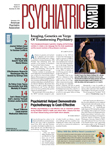As hours of daylight dip to annual lows in the northern hemisphere, psychiatrists can expect to hear more patients report seasonal mood disturbances.
Some patients have seasonal affective disorder (SAD), which affects an estimated 1 in 35 people in Canada and 1 in 200 in the United States.
Beyond having pervasive low mood and other common depressive symptoms, some patients sleep and eat more and gain weight. Their symptoms commonly emerge in October and November, peak in January, and remit in the spring. In the southern hemisphere, SAD also occurs in winter months.
Diagnosing SAD is challenging because the clinician must characterize depressive episodes that go back many years, noted Raymond Lam, M.D, a professor of psychiatry and head of clinical neuroscience at the University of British Columbia in Vancouver. Indeed, the typical patient diagnosed with SAD at his clinic, a 38-year-old woman, reports 10 previous episodes of winter depression. Light therapy, starting in late fall, can prevent or minimize such episodes.
Seasonal worsening of moods may complicate nonseasonal depression, Lam said. Up to 15 percent of patients with recurrent depression seen in outpatient psychiatric clinics describe a seasonal winter pattern.
Level 1 evidence supports light therapy's use for SAD (also known as seasonal major depressive disorder [MDD]), according to a report by the Canadian Network for Mood and Anxiety Treatments published in a supplement to the October
Journal of Affective Disorders. Lam was among its authors (See
Psychiatrists Develop Therapy Guide).
Research in progress aims to see if light therapy also benefits patients with nonseasonal MDD, bipolar disorder, attention-deficit/hyperactivity disorder (ADHD), and other psychiatric disorders, Lam said.
He and colleagues, for example, are conducting a randomized, double-blind, placebo-controlled clinical trial to assess efficacy of both light therapy and ion therapy in combination with the antidepressant fluoxetine in the treatment of MDD. High-density ion therapy delivered by a negative ion generator, like light therapy, has been found to relieve symptoms of SAD.
Various Combinations Under Study
The researchers plan to enroll 216 patients with nonseasonal MDD at six Canadian centers over three years. Study participants will take a pill and use either a light-therapy or ion-therapy device for eight weeks. Half the patients will receive a placebo pill, and half will use an inactivated treatment device, enabling researchers to assess outcomes of the various treatment combinations.
The investigators will use standard validated scales, including the Hamilton Rating Scale for Depression, to measure treatment outcomes. They also will examine moderators and mediators of treatment response. Funding comes from the Canadian Institutes of Health Research.
Light therapy generally works best for SAD when used in the morning, soon after awakening. Morning light may, however, have destabilizing effects in people with bipolar disorder, noted Dorothy Sit, M.D., an assistant professor of psychiatry at the Western Psychiatric Institute and Clinic at the University of Pittsburgh. It may trigger a switch from depression to hypomania or mania, ultrarapid cycling between states, or suicidality.
Will Bipolar Patients Benefit?
In a pilot study, Sit and colleagues assessed safety and efficacy of differing doses of light therapy for depression in nine women with bipolar I or II disorder. “We were surprised by our patients' exquisite sensitivity to morning light,” Sit said.
Three of four subjects receiving morning light therapy developed mixed states, the researchers reported in Bipolar Disorders in September 2007. Of the five women with bipolar I or II disorder treated with midday light, however, four achieved stable sustained improvement.
Positive results from light therapy would be especially welcome in bipolar disorder, Sit said, because the effectiveness of existing therapies for this disorder is limited, and treatment resistance is common.
In October, Sit and colleagues began enrollment of a planned 80 subjects in a randomized, double-blind, controlled trial to assess the efficacy of midday light therapy in women and men with bipolar I or II disorder during an acute or chronic depressive episode. The National Institute of Mental Health funded this four-year study.
The light dose will be titrated over six weeks, starting with 15 minutes daily between noon and 2 p.m. for one week, adding 15 minutes each week for three weeks, and continuing with 60 minutes daily for weeks 4 to 6. Half of the subjects will use an active light-therapy unit, and half will use an inactive comparator.
Responders will remain on the dose of response in the acute phase of the study and in the 18-week continuation phase, Sit said, permitting researchers to assess the durability of response. Subjects on a stable dose of antidepressant and antimanic medications will stay on them throughout the study. The researchers will evaluate changes in depression and manic symptoms.
In a Canadian study, 29 adults with ADHD, some of whom had mild SAD, received morning light therapy in a three-week open trial in fall and winter. Subjects' sleep and activity preference shifted to an earlier time.
This shift was strongly correlated with alleviating subjective and objective deficits in maintaining effort and arousal and improving problems with inattention, independently of changes in mood, according to Robert Levitan, M.D., a professor of psychiatry at the University of Toronto. This finding, he said, suggests that light therapy may offer clinical benefits beyond treatment of SAD.
